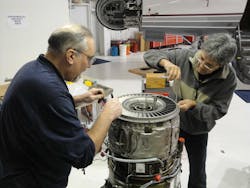Joe Sabatini, director of business development, Thornton Aviation, joins AMT for this edition of the Director of Maintenance Discussion to talk about logging aircraft maintenance and the signed Approval for Return for Service logbook entry.
Sabatini with two other partners started Thornton Aviation in 1984, then known as Thornton Aircraft, and served as the chief inspector and director of maintenance for nearly 25 years. He rejoined Thornton in 2021 and works out of the company’s Hollywood Burbank Airport location. Thornton's main location is at Van Nuys Airport and today the company is owned by Stephen Zimmerman.
AMT: To start, what’s the process for when an aircraft comes in for work?
Sabatini:
Well, the process would entail a customer coming to us asking us for maintenance on their aircraft. Typically, they ask for a quote. Some of them don't. They just say work on it. But mainly we do a quote, so they know what they're getting into. We meet with them, go over the quote. Our director of maintenance makes sure that all the pieces are in place as per our repair station manual.
Basically, do we have the housing for the aircraft job? Do we have the experienced people? Do we have parts? Do we have the appropriate data, technical data and tooling? And that's the first step. Of course, we get the customer to sign terms and conditions and give us a credit card or whatever (payment) arrangements we make with the customer.
We do big C checks and 48 months, 72 months inspections that are obviously scheduled in. But the day-to-day maintenance is just, we get a call –‘Hey, we got a bad tire, or the APU is not starting,’ or whatever the case may be, and we fit them in the schedule as we can. Obviously, if they're the customer AOG, they get a little higher priority.
AMT: How many would you say you're working on, let's say a month, on average?
Sabatini:
Oh, I would say we probably open 50 to 100 work orders a month. We've probably got at least 60 technicians. And we have four AOG teams. So, we've got all the vehicles, vans, trucks, for the support on the road. We go to Las Vegas. We go up to Oakland. Anything that's a drivable distance, we'll travel to work on airplanes. That's an AOG basis. We've got a Falcon 2000 in here currently. We're doing a 2C inspection, landing gear overhauls, cabin management system installations, all sorts of good stuff.
AMT: After meeting with the customer, what are the next steps once you're getting underway with the work?
Sabatini:
We open a work order and all these procedures are lined out in our repair station manual. We happen to use CORRIDOR as our maintenance program. It's not a maintenance tracking program, but it's how we do our invoicing and our billing and our discrepancies and corrective actions. It tracks labor, parts, all that good stuff.
So, we open a work order, we enter all the items. Let's say we're doing a 72-month inspection on a G4. The customer will usually provide us with a do list. We'll take that do list, we'll enter it into the work order. It'll be itemized based on airframe, engines or avionics or APU. And then, the work is issued out to the technicians. They perform the work. We've got inspectors following up on everything. We also have a couple internal forms that we use that the FAA has recognized. We have a form that we tape to the outside of the airplane basically saying what's going on, whether we can put power on, or no hydraulics or something – just a warning.
When everything's done, that form is taken off the airplane. There's some tasks to do on the back, make sure the airplane's ready for the crew to come and we sign that off. And then, there's also another set of forms that we use for open and close. For any panels that were removed, we have a log for that. And then, we go back and we attach red streamers to everything that's been opened up. So, we can't miss anything.
AMT: And is all this done through CORRIDOR or is a lot still actual paper?
Sabatini:
Well, yes, there's still paper involved. Like I said, that's documentation that the FAA is approved in our repair station. But all the discrepancies are, let's say, the do lists, they'll all be noted as a discrepancy, or an inspection basically. And then, there's an area for airframe inspections, and then there's an area for airframe discrepancies. So, all the inspections will be listed under inspections, and anything found wrong will be listed under the discrepancies. As we go along, we work what we can. It depends on how we arranged it with the owner of the aircraft or the operator. Sometimes, they set maybe a cost limit on a part. If it's over a thousand dollars, we need to get prior approval from them. Or some people don't care. They say, "Just get it done." There's a lot of paperwork back and forth, if we need to get authorization to, say, replace a hydraulic pump or something like that. We'll go out, shop it and find it. And then, we get approval to go ahead and purchase it from the appropriate vendors.
For the Part 135 operators, they're a little different in that they've got a general maintenance manual that we have to abide by. They've got their own return to service specifications in there. All of our guys that work on each operator's aircraft have been vetted by them, whether they're just an inspector or an RII (required inspection item) inspector. Because a lot of the items on a 135 is RII. Like an engine change, your landing gear change or any time you have to address anything to do with flight controls, or something similar that's a major area of the airframe or engine.
AMT: So then, once the maintenance is all wrapped up, where do we go in the process then?
Sabatini:
Once all the discrepancies are corrected, signed off by the technician, then an inspector goes back through, looks at the areas necessary, and then he signs his “inspected by” on the CORRIDOR system. Like I said, that's all tracked. The hours are tracked and the new parts are tracked. Once you've got a clean bill of health on your work order, it's all signed off. Then it goes to the return to service process where the logbook entry will be made. If it's, like I said, a Part 135 aircraft or part 129, 121, whatever it may be, we have to go abide by their regulations of how they want to see things return to service. They all have different verbiage for the release.
AMT: I don't want to make you go through all that different verbiage, but what are the key points between each one?
Sabatini:
Well, all the charter operators, they're all pretty much a blanket type of manual that somebody started with a template and everybody's put their own spin on it, that they've handed to the FAA and the FAA has signed off on. One operator, like I said, might want an RII on an engine change and another one might not. So, we've got each operator's GMM (general maintenance manual) that we work on their aircraft. We're basically directed by them. The charter operators have maintenance controllers that basically they're the go-between between the operator and the maintenance department.
Or, the maintenance schedule I should call it. They're handed a group of aircraft for some of these big charter operators. They might have five or 10 aircraft that they have to watch over. So, we're in direct communication with those guys all the time.
And then, they do onsite inspections while the aircraft's going through work. To go back to the repair station, everybody's been, like I said, vetted for what their expertise is. Or, what their inspection capabilities are. And of course, there’s the drug and alcohol program that is mandatory. Any contractors we may use for special purposes, NDT or plating or anything like that. They've shown us their drug and alcohol program as well. All our capabilities list, our A01, our repair station, all that's on our website for anybody to view.
AMT: To sum up, any final thoughts or general best practices our audience should keep in mind?
Sabatini:
Well, it all comes down to experience level and using the appropriate data. I don't want to make this sound flippant, but it's all nuts and bolts. Use the appropriate technical data or manual and tooling.
About the Author
Walker Jaroch
Editor
Contact: Walker Jaroch
Editor | AMT
+1-920-568-8399
>> To download the AviationPros media kits, visit: Marketing Resource Center
>>Check out our aviation magazines: Ground Support Worldwide | Airport Business | Aircraft Maintenance Technology

